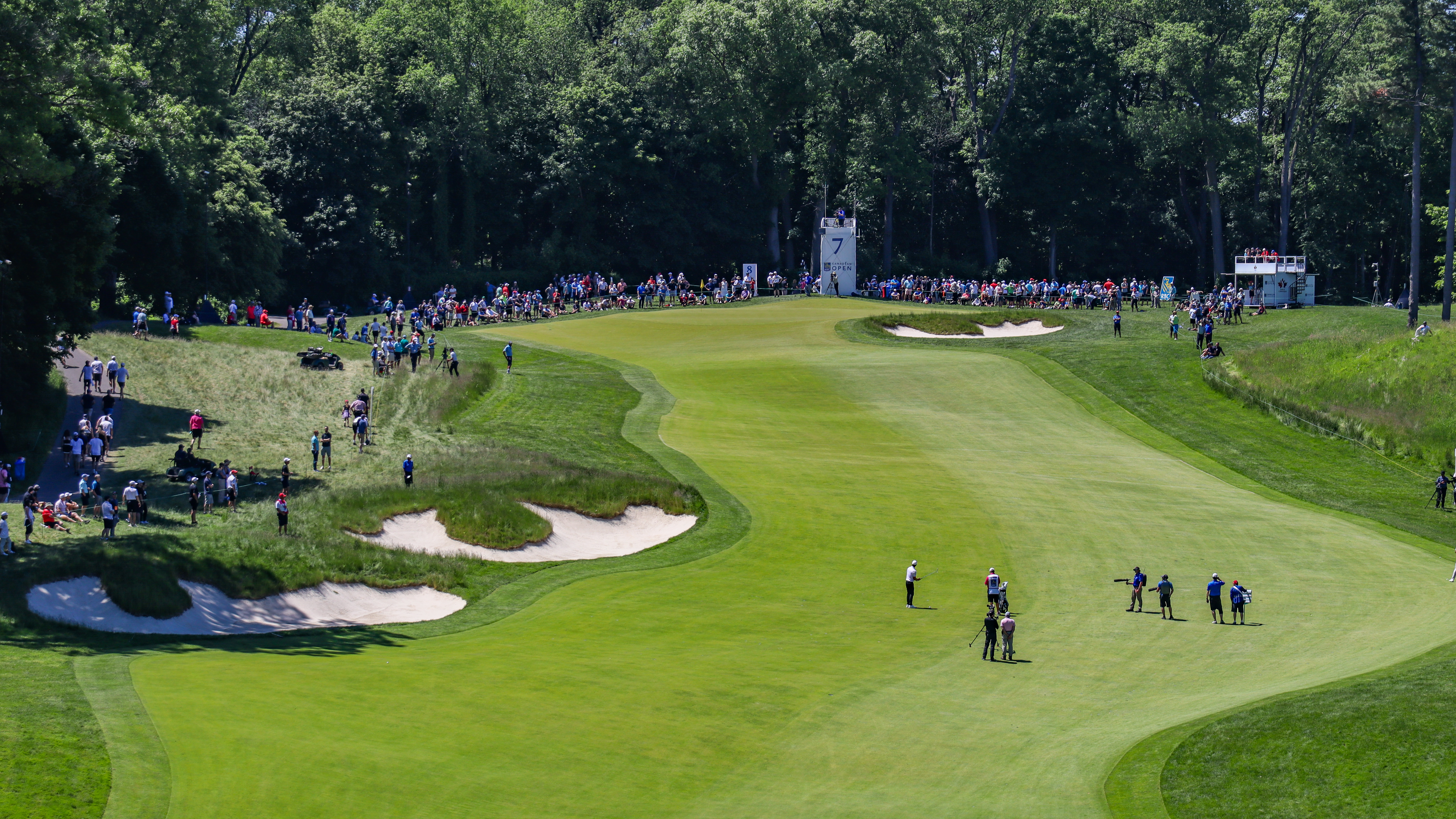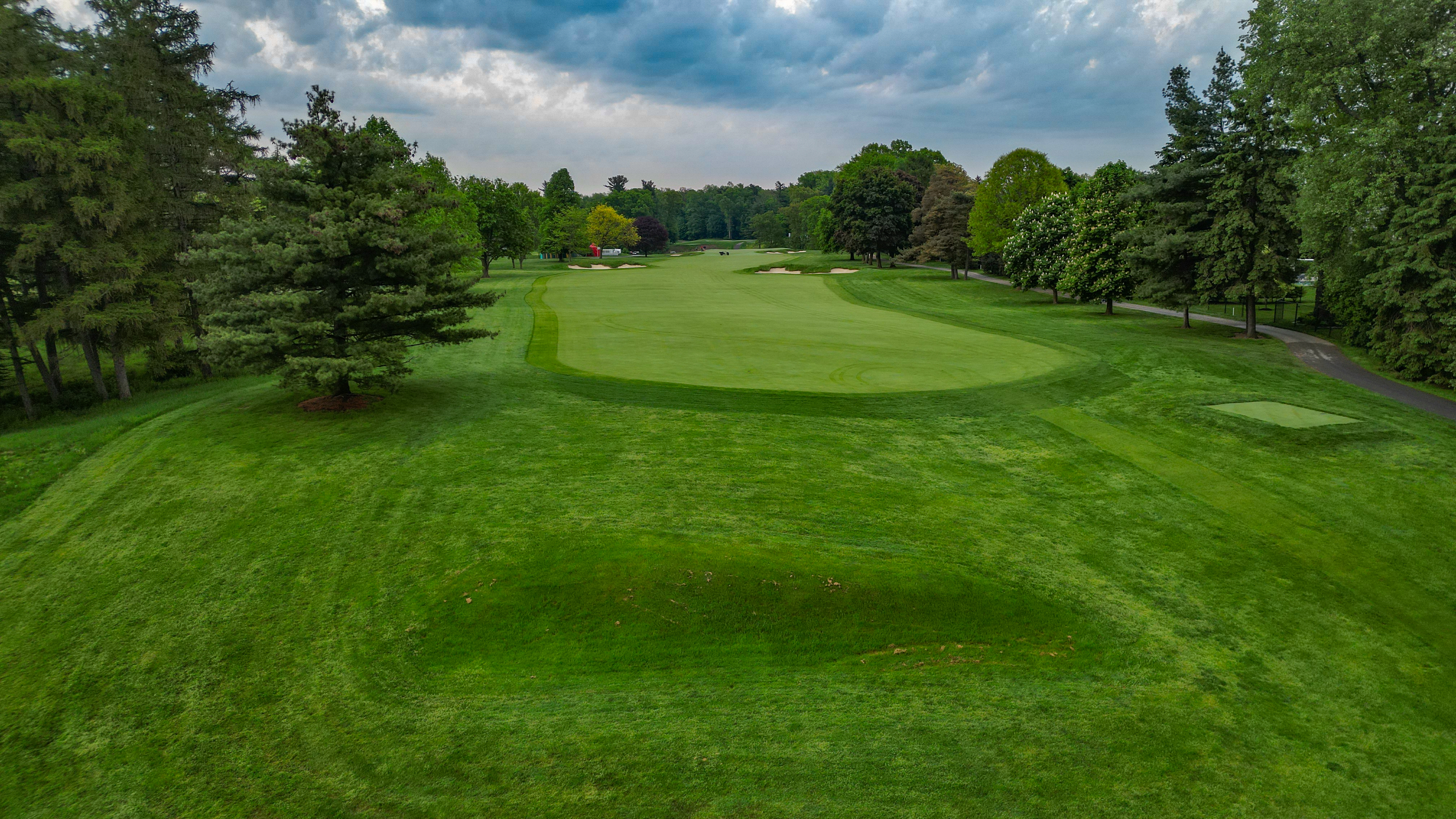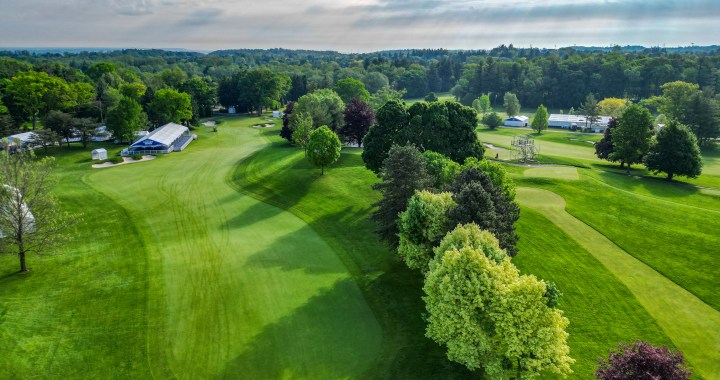
In Conversation with Martin Ebert on Criticism, Hamilton, Virtual Golf & More
There’s an excitement in Martin Ebert’s tone as he discusses his projects, standing just right of the 1st hole as Rory McIlroy launches driver down the first fairway at Hamilton Golf & Country Club during the second round of the 2024 RBC Canadian Open. Ebert is the architect behind the overhaul of Harry Colt’s Hamilton Golf & Country Club that re-opened in 2022, so Ebert flew from the centenary celebrations at Lima Golf Club in Peru to catch the action of the 2024 RBC Canadian Open—the debut of the renovation, so-to-speak, being the first time the general public steps foot on property following the 2019 event of the same title.
With a Royal Troon hat on, an R&A belt, and a company shirt, Andrew Harvie and I sat down with the architect to discuss numerous topics, including Hamilton’s renovation, virtual golf and the future of the practise, criticism and how the firm responds to it, and more.
Alex Hunter (Hunter): What are your favourite elements of the property at Hamilton, and what would be the special characteristics of the site?
Martin Ebert (Ebert): There are parts of the site which are almost too steep, but that is what creates the exhilaration of some of those tee shots at the 3rd and 7th, for example. I think that view now from the 5th green is also excellent, as is the walk up the 18th hole—it is just a great setting for golf.

Hunter: What goes into a renovation of this magnitude, and specifically, how do you balance the historical element, while also trying to tackle the modern game, and perhaps putting your own spin on it—all while keeping the members happy?
Ebert: I draw a comparison between our work at Hirono and Hamilton. Hirono in Japan is Charles Hugh Alison’s masterpiece, and we had such great photographic evidence of the course from 1930 which was amazing. The club really did want to restore what Alison left them with, but I’ve gotten to know the circumstances more and more, and discovered that he was only there for a week, so there are lots of other people who deserve a huge amount of credit as well. He designed a brilliant routing and he left good direction with all his plans, so we tried to determine what exactly he wanted there. We obviously look at the modern game as well, and in Hirono’s case, they are hosting the Japan Amateur this June, so that’s why we put in some additional bunkers and some added length to toughen the course up slightly.
Hamilton is interesting in this respect. Even on this first tee, these top players are really deciding what to do with the new bunkers. Rory, of course, hits driver as he normally does, and then a lot of guys are laying up—some in the bunker on the left!


So, Hirono was very much a direct restoration with the addition of some features that were to add some difficulty for the best players. Hamilton could be, in my view, regarded as Colt’s unfinished business. We began researching everything we could possibly lay our hands on; it was great that the old Colt plans were available, but we know that Mr. Colt did not supervise any of the construction. We had Alison’s report from October 1920 that described the work was carried out faithfully in regards to the routing, but the fine detail of the greens and bunkers left a bit to be desired and they didn’t blend into their surroundings, to paraphrase Alison. That’s where I tried to imagine what he would have wanted: the descriptions of the ‘torn out faces’ of the bunkers, as an example. He would have probably been very happy with a very rough, eroded appearance, as bunkers were in those days—especially the ones back home in England at some of the heathland classics that would have provided him with inspiration. But, in modern day golf, people want something perfectly manicured, so our take on it was to create very irregular bunker shapes with rough grass on them, but perfection all the same.
Andrew Harvie (Harvie): Speaking of restoring classic features in the modern era, was there ever thought to restoring some of Colt’s top-shot or aiming bunkers on holes like the 1st, 2nd, and 5th?
Ebert: Your article [The evolution of Hamilton and assessing the Martin Ebert & Tom Mackenzie renovation] was so interesting, because I’d never heard the term “top shot” bunkers, and when you think about it, it makes perfect sense! Bunkers to catch a topped shot. But it made me wonder if we should have pushed for the inclusion of those. However, in the modern era, you have to think about how much it costs now with the modern specifications of a bunker, and if it is worth putting bunkers in that are really irrelevant to the way we think about the game today and would only impact the poorer players. As Tom Simpson put it, ‘The poorer golfers carry their bunkers with them.’

You mentioned [Royal] Worlington in that article, and I love that golf course. There’s a bunker which is about 50 yards in front of the fairway all the way across. The club did come and say, “well, should we take that out?” And I said “no, I don’t think you should.” It’s part of the history; it is what was and still is there, but the bunkers at Worlington are just a bit of sand in the bottom and there’s no liner in them or anything. In North America, there’s a lot more maintenance and construction cost with the expectations on conditioning to keep bunkers pristine.
It was a surprise how many short bunkers he put on his plans, though. The second, for instance, just set into the face of the hillside short of the fairway. You can imagine the 7th at the Old course at Sunningdale being a little bit of an inspiration for just hitting it up and over a hazard. We didn’t restore them here [Hamilton], but I’ll go around the next couple days and think, “would including any add to the ambiance of the historic nature of the course?”
Hunter: Most of the work at Hamilton happened during the COVID-19 Pandemic. How did you tackle the challenge of doing everything remotely and not being on-site?
Ebert: It was a very scary situation, really. I came in the September of 2019 to get the job started and meet the contractor for the first time. To get everyone on the same page and to describe what we wanted. After that, I was going to come another two times that year, but the rain came down so we stopped work once, and then the snow and ice came down so I couldn’t come the second time. Finally, the pandemic hits and you don’t know how you’re going to cope with this.

We produce very detailed plans and we have had people build greens exactly as we’ve drawn them in places like Finland. There the construction team did not have any shaping knowledge but they were building greens exactly to the levels we requested with very accurate GPS equipment producing excellent results. Indeed, our plans can be put into the machinery to assist the shapers. We felt confident after some of those jobs that this could work, and we added drone surveys of the green bases and at the root zone stage so that we could compare the contours that we designed to make sure they matched with the as built elevations.
It ended up turning out really well and the team here did a great job. There was a doubt as to whether or not the drone surveying would be accurate enough to give the fine detail, but we’re designing greens at 6.25 centimetre contours and we put 25 centimetre contours across the entire property, so we were able to get great accuracy even remotely.
The club also used a 3D camera, taking photographs and videos of bunkers and green surrounds. That allowed me to get the feeling of the bunkers and the shaping: it was like I was there, putting a VR headset on in the kitchen at home and it felt like I was walking into the bunkers, so that was brilliant.
They built the bunkers to the detailed plans we produced as well. They would spray an orange line onto the faces and send me photographs. They were generally quite simple lines that they sprayed, and then I’d go a bit crazy with them. They would cut them out, spray the line again, and send another photograph back to me and I’d put the finishing touches on it. Honestly, that was probably better than me coming out and spraying the lines on the ground myself because quite often, wet conditions with steep high bunker faces means you’ll be slipping around while spraying a line and you won’t like it when you step back. It was much easier to do it on a screen. The best combination now is to be on-site, study the bunker, take a photograph, draw a line and then let the guys cut it out, because we [Mackenzie & Ebert] are plans people, not bulldozer operators. Sometimes we get criticism for that., The shapers who do it on the bulldozer are extremely talented, but we feel there are multiple ways to get great results.
Hunter: Having been essentially forced to using new technology on this renovation, do you think you’ll continue to use it moving forward?
Ebert: We’re still drone surveying greens for certain projects now because we want to be certain of the exact slopes we’re creating and how close we are to the existing surfaces. We’ve used a 3D camera in Chile to avoid the expense and carbon footprint of making long distance flights to build just two bunkers. Any technology helps, but it doesn’t take the place of actually visiting the site for major projects.
Hunter: When approaching a renovation at any golf course that hosts championships, do you pay attention to any data like Shotlink or anything similar?
Ebert: Absolutely. Yes. I wish we had it more widespread in the UK. In our case, we want a spread of tee shots on as many holes as we can get, meaning that different strategies and approaches are taken by the top players. I’d love to see the data if it’s available to see if we’ve achieved that.
Hunter: How do you think Colt’s trip to North America impacted his style and evolution?
Ebert: At the time, Colt was in his formative design years, I would suggest. People often say “there’s a Colt bunker style,” but we have a series of photographs of his courses when they were first opened and there was a huge variation in the bunker style. Is that because of the difference in the landscapes and the differences between the golf courses? Or perhaps it was because his thoughts and ideas changed throughout his career?

Specifically in North America, it is reasonable that being exposed to other people’s work—and working with other architects like Ross, for instance, at Old Elm and Glen View—had influence on him as well. I would suggest that Colt and his contemporaries are the gentlemen who really invented architecture, as opposed to the great professional golfers like Old Tom and Willie Park Jr. who laid out courses more simply across the natural shapes of the ground and arguably adding a few rather artificial looking features. Harry Colt and his contemporaries really started to think intellectually about design, and they were certainly developing their thoughts over that period and evolving as creative designers.
Hunter: What’s been the biggest change in the industry from when you began your career to now?
Ebert: I will say that after 34 years, I’m almost more excited about the work we’re doing now than back then! Donald Steel, our old boss, didn’t draw detailed plans. He would draw up simple routing plans, but we had to learn how to draw the detail of the courses. Tom [Mackenzie] is a landscape architect, so he would produce these lovely sketches of the landscape. I cannot sketch, so that didn’t suit me, but I was an engineer and could draw contour plans, as could Tom. That’s what we deliver now in terms of contour plans and detailed plans, but back in the day, we used to put the same piece of paper through an archaic photocopier to get black, green, and blue colours on the same piece of paper to represent different elements of the plan. For layout plans, we would draw on a piece of tracing paper , writing every letter with an ink pen using a stencil. It was incredibly laborious.
I don’t know how we coped, really. So, with the advancement of technology, using AutoCAD and other programs, it’s just become a lot easier to produce accurate plans and the way the courses turn out because of that is incredible. Now, with our plans, we can create 3D models of holes and courses, and we have an in-house CGI department that produces incredibly imagery using the models to be able to show the clients what their courses, or the changes to their courses, will look like. It’s good for planning. We use it to review our designs. In that respect, it’s amazing. If you want to show the construction team or a shaper what you’re trying to achieve, we can show them as well. In addition, it produces incredible marketing stills and videos of the courses. Taking this even further, we are now working with a couple of companies to get the 3D models into their simulator software so that our clients can play the golf courses before they are built; I don’t think we’re too far away from that, and that’s very exciting. But all of this is only possible because we produce seriously detailed plans.
Hunter: It’ll be interesting to see what happens 100 years from now!
Ebert: Yes. The scary thing for me is, at that point, do we then get into virtual golf courses where it’ll never be built and you’re just playing that golf course on a simulator or with a headset? It would be a lovely idea in a way just to go around and find the most amazing stretch of coastal land that exists in the world, that you’ll never get permission to build upon, and then just play the golf course virtually. At that point, it’s a simulated experience, but this [standing outside next to the first tee at Hamilton] is what it is all about. Getting on the ground, teeing off at places and just experiencing the setting. At Turnberry, you get to experience the lighthouse, Ailsa Craig and the ocean, so it certainly won’t replace that feeling.

Hunter: What differences do you notice between golfing culture in the UK and Canada/North America?
Ebert: There’s one characteristic which is really important to me, and I’m not saying it doesn’t exist on this side of the pond—-I haven’t been to Bandon but I’d love to go—but it’s the turf condition and the difference in it. Over here [in North America], courses are presented in immaculate condition, but I think the resilience that links turf can offer, and the way the turf affects the club and ball contact is just so different. That is one aspect of why I think links golf is the best form of the game.
Even the format of how people play golf is different. In the UK, foursomes (alternate shot) is still played a lot at traditional clubs whereas it is rarely played in North America although I am a member of a society over here that only plays, and indeed celebrates, foursomes. I wish more people would play foursomes, because on a winter’s day, you are always moving and you could be finished in less than 3 hours, then lunch and you might play golf again! Oh, and the drinking culture as well—I really need a bit of swing oil before I go out for a round and it has proven difficult to find a drinking partner before playing over here!
Hunter: Where is your favourite place to play golf?
Ebert: I gave a hint of it earlier, so it would have to be one of the great links courses really. I’m fortunate to be a member of the R&A and to be able to play in the Spring and Autumn meetings and other events at St. Andrews, and I find it so hard to go away from that. The quality of the turf, the whole ambience, the course and town melding together. The quality of the holes, too, because you never get bored. I know some people don’t get what is special about the Old Course the first or second time because they might not know where to go, but I think when you figure that out, the holes can change so much depending on where the flag is, and it’s playable! That’s the other thing: even as someone who doesn’t play very often, occasionally, you can play half decently. That’s what people want: you don’t want to be beaten around the head and by the end of the trip you’re thinking, “I’m happy not to come back here for a while.”

Hunter: So looking forward to the open at Troon, what are some things we should be looking out for?
Ebert: We’ve lengthened a number of the holes because there’s such a concern over how far the best players are hitting the ball and we want the holes to play as intended. The 4th has been lengthened significantly and that will make a big difference to this par 5 as it has at the 17th here at Hamilton with the new green around 50 yards further on in that case. We get asked a lot about “what have you done to the first three holes,” as they are relatively short and easy but for me, courses have different rhythms and Troon is probably one where you’re looking to make a good score on the first six holes to get ready for the tough back nine. When you think through those holes: the 11th along the railway line, which has been lengthened slightly, the 13th and how incredibly tough that is to its raised green, and the 15th which we restored back to its old playing line for the last Open at around 500 yards; they are seriously difficult. We moved the 16th tee over to the left of the 15th green to where it used to be, which will result in a better hole and a lot less disturbance with the road and the main spectator village. The back nine will be a serious test.
In addition, I think of the Postage Stamp and how much these golfing events are growing as well. Jordan Kitchen, the superintendent here, said how the Canadian Open is 50% bigger this year than in 2019, and The Open is similar now too with an amazing grandstand being formed for this incredibly short but dangerous hole. As a result, the scene at the Postage Stamp will be incredible. It will be the place to be.

Hunter: Can you give us some brief thoughts about the rollback?
Ebert: I think it’s essential. I’m curious to see if it just keeps things where they are right now by the time it is implemented? I am in favour of it being the same for everyone, but I’m curious what the impact on the ordinary golfer over 18 holes will be. If we think that a majority of people play courses that are too long for them, if the impact is 100, 150, 200 yards or whatever, does it give us the opportunity to actually say to clubs we need to rethink the length of courses that regular golfers play? If it does make a significant difference over 18 holes and allows us to edge club golfers forward, I think it will help everyone’s enjoyment. For the elite level players, even if 10-15% is taken off their tee shots, we are all still going to have our minds blown when we actually see them strike the ball… that reduction of distance doesn’t worry me in the long term and will help the classic courses remain relevant for modern day play.
Harvie: On a renovation like Hamilton, with 18 Colt drawings and a routing plan, what’s the process for you as you go through and think “we have these drawings, but we’re going to do something different.” Was there any consideration to restore it back, or has the game evolved past that point?
Ebert: It has been a long time since we started this process so it is difficult to remember the full detail, but, for instance, we looked at his hole plans for the 4th and it showed a rough hollow up the left. When we arrived, that had been replaced with a bunker and some awkward shaping, so that was an important aspect of Mr. Colt’s intentions for the hole and we put that back. That was something we used the hole plans for, but it was very much of dealing with his proposals on a case-by-case basis. We went through every hole and just thought, “Okay, what was the intention? Where are the bunkers.” If this had been a full restoration, the course wouldn’t have the relevance it needs for the modern game. So, we put the bunkers back that made sense, added other bunkers and gave them all our modern taken on the ‘torn out face’ description that Colt made. Of course, it was also important to work with the committee and deliver what they wanted after debating all aspects to make sure what the club did want made sense.

Harvie: There’s been some criticism of some of your firm’s work at places like Royal Liverpool and even from us on Hamilton. How does that affect your process moving forward? Do you consider what they’re saying, or do you stand behind your work and what you’ve produced?
Ebert: I don’t think you ever stop learning in our game, so any feedback is good as long as the feedback is based on fact! I have had criticism that I “shouldn’t be allowed anywhere near a links course,” and they were naming links courses I had never even worked upon. Royal Liverpool provides an interesting example. With the Open 17th hole, we have now filled in the bunker on the right hand side, and the front bunker is now separated from the sand area in the carry. The dangerous sand area over the green is going to have grass covering the area much further down the bank, and the tees have been rearranged so the members play it further to the right side and a little higher so the view of the green is better. However, that is all per the original design concept that we drew up and, for one reason or another, changes occurred to produce the hole, which was so popular with the spectators, for last year’s Open. To be honest, I’m a bit worried that the removal of the sand area over the back of the green is going to take some of the fear out of the minds of the players but it was so tough for the members. However, the hole only plays at a maximum length of 138 yards.
So, we definitely review criticism and one area relates to some comments about sand areas we restore to our links. On occasions we end up with them being a bit too intricately shaped, and they should look a bit more natural and we should let nature take its course a little more so that is something we are working on. In addition, we are always looking at the green shapes and green designs and reviewing how well they blend in with the rest of greens on the golf course.
We are very aware of commentary about our work, ignore what is irrelevant or not based on fact but we like to learn from anything which does make sense.











Thought Hamilton Golf Club stood up very well to the World!! The Rink on 13 was pure Class!!
Bill Bamber
Edmonton Alberta